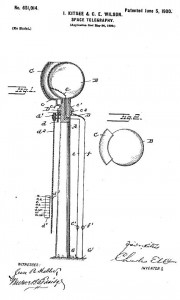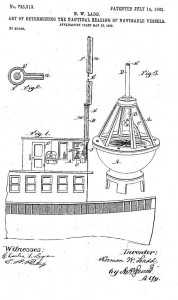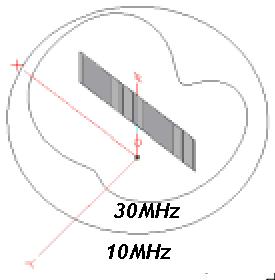
Communications may have been the first commercial application of wireless technology, but Real-Time Location Systems (RTLS) were close behind. In the first few years of radio, a variety of aggressive inventors recognized the problem of RTLS and leaped to offer solutions. Some of their ideas illustrated the inventors’ misunderstanding of the behavior of radio waves. Inventors assumed (erroneously) that long wavelength RF signals would cast sharp shadows in an optical fashion. Isidor Kitsee and Charles E. Wilson, for instance, proposed a spherically end-loaded antenna with a shield to block signals from a particular direction. [[1]] The Figure (left) shows the Kitsee-Wilson antenna.

Hermon W. Ladd similarly proposed a whip antenna with a rotatable shield. [[2]] In Ladd’s proposed system, a narrow slit in a rotating shield is supposed to allow the antenna to be illuminated only when the slit is aligned with the direction of incidence of the signal. Both these DF antennas fail to work, because the low frequency signals (typically <300kHz) they aimed to detect have wavelengths too long (typically >1km) to be shadowed by such a small shield or to illuminate such a small slit. The Figure (right) shows Ladd’s direction finding system.
The well known radio inventor, Lee de Forest (1873-1961), fell prey to a similar confusion. De Forest assumed that the larger the antenna’s physical cross-sectional area, the more signal would be collected. This is not necessarily true even for an antenna comparable in dimension to a wavelength. For an electrically small antenna, actual and effective aperture are often two different things. Nevertheless, de Forest argued:
“…a large screen will collect a larger amount of energy than a small one…. When such a screen is broadside onto the waves – that is, normal to their direction of travel – it will manifestly collect the largest possible amount of energy, while it is edge on, or in a plane coinciding with the direction of travel of the waves, it will collect the smallest amount of energy.”[[3]]

The Figure (left) shows de Forest’s 6ft by 15ft capacitive “collecting screen.” [[4]] This antenna actually exhibits an omni-directional reception pattern for frequencies below 25MHz. Only at 30MHz where the antenna begins to be an appreciable fraction of the 10m (30ft) wavelength does the antenna pattern begin to deviate. Even there, the deviation enhances reception in the plane of the antenna, not broadside to it.

The Figure (right) shows a NEC simulation of the azimuthal pattern of de Forest’s antenna at 10MHz and 30MHz. De Forest’s claim to be able to detect a seven-mile-distant station to an accu racy of within ten degrees using this system seems unsupportable given the LF (<300kHz), long-wavelength (>1km) nature of the transmit signal.
racy of within ten degrees using this system seems unsupportable given the LF (<300kHz), long-wavelength (>1km) nature of the transmit signal.
The first RTLS aimed to locate a transmitter by finding the direction of incoming signals. They failed. Next time: The First Direction Finding Systems.
[[1]] Isidor Kitsee and Charles E. Wilson, Space Telegraphy, US Patent 651,014, June 5, 1900.
[[2]] Hermon Ladd, Art of Determining the Nautical Bearing of Navigable Vessels, US Patent 733,910 , July 14, 1903.
, July 14, 1903.
[[3]] Lee de Forest, Wireless Signaling Apparatus, US Patent 771,818, October 11, 1904.
[[4]] J.A. Fleming, The Principles of Electric Wave Telegraphy, (New York: Longmans, Green, And Co., 1906), pp. 631-633.
